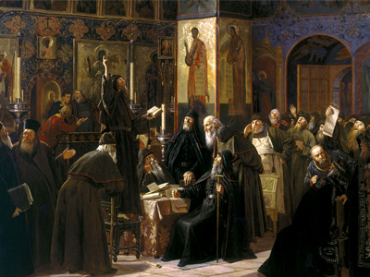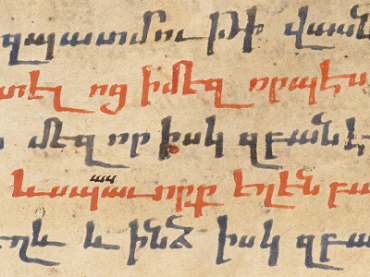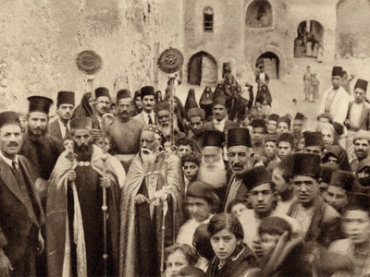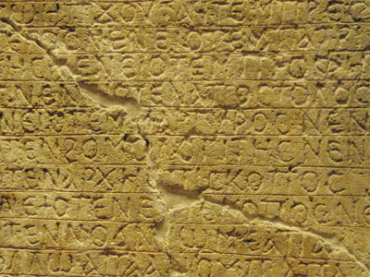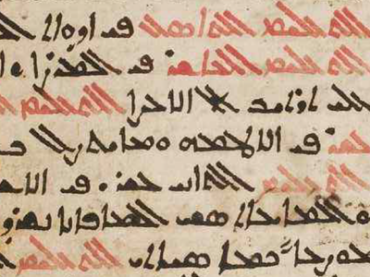Syriac and Eastern Christianity
Index of Notable Persons in the Syriac Tradition within Select Arabic Sources
An Adaptation of G. Kiraz’s Catalogue at the Beth Mardutho Research Library
Compiled by Emilee Walker Cornetta; Foreword by George Anton Kiraz
Series: Gorgias Handbooks 24
ISBN: 978-1-4632-0162-3
This volume contains the contents of George Kiraz’s catalogue of over 1300 people and places related to the Syriac tradition, expanded to include Latin names and citations as well as references to the Gorgias Encyclopedic Dictionary of the Syriac Heritage.
$106.00
Journal of the Canadian Society for Syriac Studies 11
Edited by Amir Harrak
ISBN: 978-1-4632-0153-1
Volume 11 includes articles by Robert Mason, Alessandro Mengozzi, Mar Emmanuel J. Emmanuel, Shawqi Talia, Edward Odisho, and Kyle Smith and is archaeology and Neo-Aramaic.
$75.00
The Jewish Dialect of Zakho
By Eran Cohen
Series: Gorgias Neo-Aramaic Studies 13
ISBN: 978-1-60724-048-8
This monograph provides an extensive syntactic description of the rather well-known but not previously described Jewish Neo-Aramaic dialect of Zakho. The description covers both microsyntax, namely, syntactic relationships within the confines of the sentence: the predicative link, the attributive and completive relationships, and apposition.
$203.00
The Book of Isaiah According to the Syriac Peshitta Version with English Translation
English Translation by Gillian Greenberg & Donald M. Walter; Text Prepared by George Anton Kiraz & Joseph Bali
Series: Surath Kthob 21
ISBN: 978-1-4632-0155-5
A new English translation of the Syriac Peshitta along with the Syriac text carried out by an international team of scholars. Greenberg and Walter have produced an annotated translation of the Peshitta version of the Book of Isaiah, while Kiraz and Bali have edited the Peshitta text. The English translation and the Syriac text are shown on facing pages so that both can be studied together.
$150.00
The Sentences of the Syriac Menander
Introduction, Text and Translation, and Commentary
ISBN: 978-1-61143-488-0
The Sentences of the Syriac Menander appears in two Syriac manuscripts in the British Library, a full version in one codex, and a far shorter version, only a small fraction thereof, in another. This book presents a commentary on the text in its complete version focusing on parallels from both Jewish tradition and the Greco-Roman world, showing that the text is not, as it claims, the work of the Greek author Menander, but rather a work of Jewish Wisdom Literature composed in Syriac, possibly in the ancient city of Edessa itself, and preserved within Christian monastic circles.
$149.00
The Syriac Tradition of the Infancy Gospel of Thomas
A Critical Edition and English Translation
By Tony Burke
Series: Gorgias Eastern Christian Studies 48
ISBN: 978-1-4632-0584-3
A long-awaited and essential tool for the study of one of the earliest texts of the Christian Apocrypha and an important text in Syriac literature, theology, and history.
$168.00 $134.40
John the Solitary on the Soul
Translation and Introduction by Mary T. Hansbury
Series: Texts from Christian Late Antiquity 32
ISBN: 978-1-60724-044-0
In this treatise, John the Solitary (ca. 390) enters into a dialogue with two disciples who have come past the beginning stage of the spiritual life and have brought him their struggle against the passions in the life of the inner person (barnâšâ gawwâyâ). John’s description of the life of the soul is outlined here in a framework of the stages of the spiritual life. Included is his analysis of the passions, showing very little if any Evagrian influence. The Dialogue on the Soul is a difficult text. It is hoped that this Syriac-English presentation will enable others to take the discussion forward. John’s genial thought merits this.
$61.00
Seeing the God
Ways of Envisioning the Divine in Ancient Mediterranean Religion
Edited by Jeffrey B. Pettis
ISBN: 978-1-61143-251-0
"When people prayed, they expected their gods to come," wrote Robin Lane Fox, providing the impetus for this volume of collected essays exploring the concept of how the ancients “envisioned” the deities within various ancient religious traditions. The perspectives of Judaism, Gnosticism, Syriac Christianity, Byzantium, and Classical Greco-Roman religion and philosophy are considered. Specific emphasis is given to phenomena such as dreams, visions, and initiatory rites mediating the divine encounter.
$143.00
Foundations for Syriac Lexicography IV
Colloquia of the International Syriac Language Project
Edited by Kristian S. Heal & Alison G. Salvesen
Series: Perspectives on Syriac Linguistics 5
ISBN: 978-1-61143-933-5
The fourth published colloquia of the International Syriac Language Project (ISLP), presenting papers from an international team of authors working to develop contemporary, interdisciplinary approaches to linguistics and lexicography.
$150.00
Foundations for Syriac Lexicography V
Colloquia of the International Syriac Language Project
Edited by Jonathan Loopstra & Michael Sokoloff
Series: Perspectives on Syriac Linguistics 7
ISBN: 978-1-61719-027-8
The fifth published colloquia of the International Syriac Language Project (ISLP), presenting papers from an international team of authors working to develop contemporary, interdisciplinary approaches to linguistics and lexicography.
$165.00
The Gospel of Matthew According to the Syriac Peshitta Version with English Translation
English Translation by Jeff W. Childers; Text Prepared by George Anton Kiraz
Series: Surath Kthob 27
ISBN: 978-1-4632-0174-6
This volume is part of a series of English translations of the Syriac Peshiṭta along with the Syriac text carried out by an international team of scholars. Childers has translated the Peshiṭta of Matthew, while Kiraz has prepared the Syriac text in the west Syriac script, fully vocalized and pointed. The translation and the Syriac text are presented on facing pages so that both can be studied together. All readers are catered for: those wanting to read the text in English, those wanting to improve their grasp of Syriac by reading the original language along with a translation, and those wanting to focus on a fully vocalized Syriac text.
$150.00
The Book of the 12 Prophets According to the Syriac Peshitta Version with English Translation
Translation by Donald M. Walter & Gillian Greenberg; Text Prepared by George Anton Kiraz & Joseph Bali
Series: Surath Kthob 26
ISBN: 978-1-4632-0177-7
This volume is part of a series of English translations of the Syriac Peshiṭta along with the Syriac text carried out by an international team of scholars. Greenberg and Walter have produced an annotated translation of the Peshiṭta version of The Twelve Minor Prophets, while Kiraz and Bali have edited the Peshiṭta text. The English translation and the Syriac text are shown on facing pages so that both can be studied together.
$150.00
From Ugarit to Nabataea
Studies in Honor of John F. Healey
Edited by George Anton Kiraz & Zeyad Al-Salameen
Series: Gorgias Ugaritic Studies 6
ISBN: 978-1-4632-0180-7
From Ugarit to Nabataea is a collection of articles on the texts and cultures of various Near and Middle Eastern societies such as Ugarit, Ancient North Arabia, Nabatea, Palmyra, Edessa, the monasteries of Mesopotamia, and modern day Syriac-speaking communities. They include discussion of the religious beliefs, iconography, epigraphy, architecture and language of these societies – fields to which John F. Healey has contributed in his long, distinguished and varied career.
$160.00
A History of the Syrian Community of Grand Rapids, 1890-1945 (hardback)
From the Beqaa to the Grand
ISBN: 978-1-61719-028-5
This book provides the first history of the old Syrian community of Grand Rapids, Michigan, 1890-1945, focusing on the slow process of ethnic acculturation during which community members developed a hybrid culture. Unlike some Middle Eastern immigrant groups, these Syrians were able to maintain their identity by establishing their own churches, which still exist today. At every opportunity this group is situated within the larger historical context, the decline of the Ottoman Empire, the French Mandate in Syria, the Progressive Movement, the Americanization program of the 1920s, the Great Depression and the two world wars.
$163.00
Exodus According to the Syriac Peshitta Version with English Translation
Series: Surath Kthob 2
ISBN: 978-1-4632-0536-2
This volume is part of a series of English translations of the Syriac Peshitta along with the Syriac text carried out by an international team of scholars.
$150.00
Leviticus According to the Syriac Peshitta Version with English Translation
Series: Surath Kthob 3
ISBN: 978-1-4632-0468-6
This volume is part of a series of English translations of the Syriac Peshi?ta along with the Syriac text carried out by an international team of scholars.
$150.00
Numbers According to the Syriac Peshitta Version with English Translation
Series: Surath Kthob 4
ISBN: 978-1-4632-0529-4
This volume is part of a series of English translations of the Syriac Peshitta along with the Syriac text carried out by an international team of scholars.
$150.00
Deuteronomy According to the Syriac Peshitta Version with English Translation
Series: Surath Kthob 5
ISBN: 978-1-61143-930-4
This volume is part of a series of English translations of the Syriac Peshitta along with the Syriac text carried out by an international team of scholars.
$150.00
Judges According to the Syriac Peshitta Version with English Translation
English Translation by Donald M. Walter & Gillian Greenberg; Text Prepared by George Anton Kiraz & Joseph Bali
Series: Surath Kthob 7
ISBN: 978-1-4632-0555-3
This volume is part of a series of English translations of the Syriac Peshi?ta along with the Syriac text carried out by an international team of scholars.
$150.00
Samuel 1&2 According to the Syriac Peshitta with English Translation
English Translation by Donald M. Walter & Gillian Greenberg; Text Prepared by George Anton Kiraz & Joseph Bali
Series: Surath Kthob 8
ISBN: 978-1-4632-0423-5
This volume is part of a series of English translations of the Syriac Peshitta along with the Syriac text carried out by an international team of scholars.
$150.00
Kings 1 & 2 According to the Syriac Peshitta Version with English Translation
English Translation by Gillian Greenberg & Donald M. Walter; Text Prepared by George Anton Kiraz & Joseph Bali
Series: Surath Kthob 9
ISBN: 978-1-4632-0586-7
This volume is part of a series of English translations of the Syriac Peshitta along with the Syriac text carried out by an international team of scholars.
$150.00
1 & 2 Chronicles According to the Syriac Peshitta Version with English Translation
Series: Surath Kthob 10
ISBN: 978-1-4632-0571-3
This volume is part of a series of English translations of the Syriac Peshitta along with the Syriac text carried out by an international team of scholars.
$150.00
The Psalms According to the Syriac Peshitta Version with English Translation
Series: Surath Kthob 17
ISBN: 978-1-4632-0639-0
This volume is part of a series of English translations of the Syriac Peshitta along with the Syriac text carried out by an international team of scholars.
$150.00
Jeremiah According to the Syriac Peshitta Version with English Translation
English Translation by Gillian Greenberg & Donald M. Walter; Text Prepared by George Anton Kiraz & Joseph Bali
Series: Surath Kthob 22
ISBN: 978-1-61143-892-5
This volume is part of a series of English translations of the Syriac Peshitta carried out by an international team of scholars. The fully vocalized and pointed Syriac text, and the English translation, are presented on facing pages so that both can be studied together. Much supplementary information is given in annotations, Addenda, and Appendices.
$150.00
Ezekiel According to the Syriac Peshitta Version with English Translation
English Translation by Gillian Greenberg & Donald M. Walter; Text Prepared by George Anton Kiraz & Joseph Bali
Series: Surath Kthob 24
ISBN: 978-1-4632-0478-5
This volume is part of a series of English translations of the Syriac Peshitta along with the Syriac text carried out by an international team of scholars.
$150.00
Filter by
Filter by price
Filter by manufacturer


